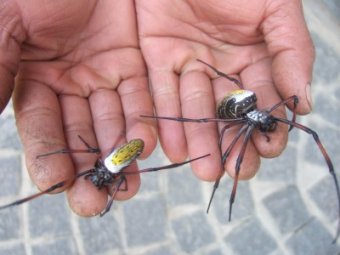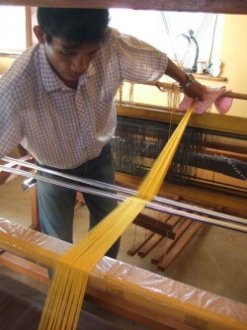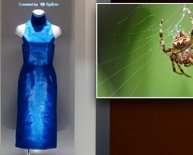
Spider silk weaving
 A rare textile made from the silk of more than a million wild spiders goes on display today at the American Museum of Natural History in New York City.
A rare textile made from the silk of more than a million wild spiders goes on display today at the American Museum of Natural History in New York City.
To produce this unique golden cloth, 70 people spent four years collecting golden orb spiders from telephone poles in Madagascar, while another dozen workers carefully extracted about 80 feet of silk filament from each of the arachnids. The resulting 11-foot by 4-foot textile is the only large piece of cloth made from natural spider silk existing in the world today.
“Spider silk is very elastic, and it has a tensile strength that is incredibly strong compared to steel or Kevlar, ” said textile expert Simon Peers, who co-led the project. “There’s scientific research going on all over the world right now trying to replicate the tensile properties of spider silk and apply it to all sorts of areas in medicine and industry, but no one up until now has succeeded in replicating 100 percent of the properties of natural spider silk.”
Peers came up with the idea of weaving spider silk after learning about the French missionary Jacob Paul Camboué, who worked with spiders in Madagascar during the 1880s and 1890s. Camboué built a small, hand-driven machine to extract silk from up to 24 spiders at once, without harming them.
“Simon managed to build a replica of this 24-spider-silking machine that was used at the turn of the century, ” said Nicholas Godley, who co-led the project with Peers. As an experiment, the pair collected an initial batch of about 20 spiders. “When we stuck them in the machine and started turning it, lo and behold, this beautiful gold-colored silk started coming out, ” Godley said.
Father Comboué, who one historical text erroneously calls Father Comboné, had a partner in designing his machine, M. Nogué. Together, they got quite a spider silk fabric industry going in Madagascar and even exhibited “a complete set of bed hangings” at the Paris Exposition of 1898. That fabric has since been lost, but the exhibition brought them some attention, excerpted below. “It should be said that the female halabe allows herself to be relieved of her silken store with exemplary docility and this in spite of the fact that she is distinguished for her ferocity; her usual treatment of the males who pay her court is to eat them and she feasts without compunction on members of her own sex weaker than herself. M Nogue’s apparatus consists of a sort of stocks arranged to pin down on their backs a dozen spiders. The spiders accept this imprisonment with resignation and lie perfectly quiet while the silken thread issuing from their bodies is rapidly wound on to a reel by means of a cleverly devised machine worked by hand.” — Great Britain Board of Trade Journal
“It should be said that the female halabe allows herself to be relieved of her silken store with exemplary docility and this in spite of the fact that she is distinguished for her ferocity; her usual treatment of the males who pay her court is to eat them and she feasts without compunction on members of her own sex weaker than herself. M Nogue’s apparatus consists of a sort of stocks arranged to pin down on their backs a dozen spiders. The spiders accept this imprisonment with resignation and lie perfectly quiet while the silken thread issuing from their bodies is rapidly wound on to a reel by means of a cleverly devised machine worked by hand.” — Great Britain Board of Trade Journal
“The first experiments of Father Comboné were made in the simplest manner. The spiders were imprisoned in match boxes and by slightly compressing the abdomen he managed to extract and wind upon a little reel turned by hand it thread that sometimes attained a length of 500 yards… it is to the ingenuity of M. Nogue, one of the sub directors, that we owe the apparatus which permits the thread to be wound mechanically and to be twisted and doubled in the quickest and most practical manner. This is done by means of a curious little machine, not easy to describe, in which the spiders are imprisoned by the throat while undergoing the operation. Young Malagasy girls go daily to a park near the school to gather three or four hundred spiders which they carry in osier baskets with wooden covers to be divested of their webs… Generally after having submitted to the reeling operation the spiders are put back in the park for a couple of weeks… [The silk’s] color when first spun is a beautiful gold and it requires no carding or preparation of any sort before being woven. Will this be the silk of the future?” — The Literary Digest
But to make a textile of any significant size, the silk experts had to drastically scale up their project. “Fourteen thousand spiders yields about an ounce of silk, ” Godley said, “and the textile weighs about 2.6 pounds. The numbers are crazy.”
Researchers have long been intrigued by the unique properties of spider silk, which is stronger than steel or Kevlar but far more flexible, stretching up to 40 percent of its normal length without breaking. Unfortunately, spider silk is extremely hard to mass produce: Unlike silk worms, which are easy to raise in captivity, spiders have a habit of chomping off each other’s heads when housed together.
To get as much silk as they needed, Godley and Peers began hiring dozens of spider handlers to collect wild arachnids and carefully harness them to the silk-extraction machine. “We had to find people who were willing to work with spiders, ” Godley said, “because they bite.”

















